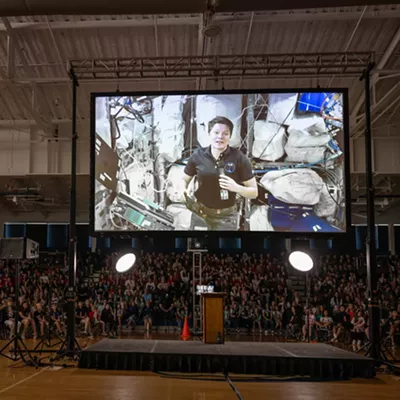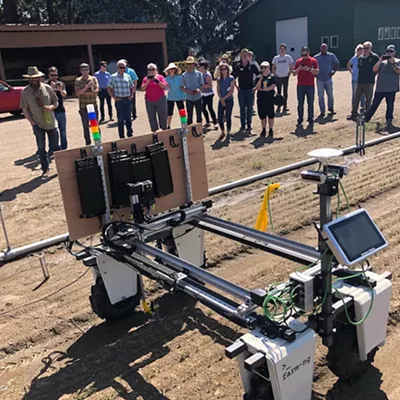Positive response to our recent column regarding the importance of establishing a research university in Spokane prompts a follow-up. Given the political lay of the land in our state and region, how might we go about gaining for Spokane what Boise and Portland have managed to attain?
First, before we examine organizational options, let's look at process. Any chance for success will be dependent upon a broad-based, well-organized and relentless effort that would involve both our elected leadership and business leadership. We know that coups don't work, as the EWU/WSU merger plotters of three years ago might have learned. No isolated group of self-appointed saviors can accomplish what needs to be done. If any community endeavor ever stood in need of public leadership it would be this one.
Which brings me to the role of the mayor. Until this last election, mayors in Spokane were little more than ribbon-cutters. Now the public can expect much more. He can't order anyone to do anything, but he does have access to all the levels of government that matter, and could, were he to have the support around him, parlay that influence into action.
Interestingly enough, it likely is the case that until we adopted a strong mayor form of government, an ambitious public initiative like a locally controlled, publicly funded research university could never go anywhere. Business leadership alone simply cannot lend the legitimacy that such an effort needs.
The creation of a research university for Spokane raises a far greater range of political questions and issues than Expo '74 ever did (an effort that, in the end, actually relied heavily on elected leadership, all our claims of rugged individualism notwithstanding). Expo had little or no redistributive impact. A research university for Spokane will be seen as having the long-term effect of moving resources from Pullman to Spokane, maybe even from Cheney to Spokane.
Certainly, the funding required to launch such an effort will require a far greater (and ongoing) commitment from the Legislature than was required by Expo.
Moreover, no doubt the Legislature will be wary of opening a Pandora's box full of prospective claimants. What about Vancouver? Or Tacoma? How can Spokane's case for its own school be distinguished?
To have any chance for success, the usual leadership will have to be content to play a supportive role. I refer to the Chamber, the EDC and other such bastions of community influence. We can't have Lone Rangers over in Olympia dropping silver bullets all over the Capitol campus. One message. One voice. Lots of carefully done supporting research. Everyone on the same page.
Never has the city have become engaged in so sophisticated and complex a public undertaking. Can it muster the will? Can it find the discipline? Will the leadership emerge? All very critical questions that must be answered before technical solutions are framed.
As to those technical solutions -- or, how to make it happen -- I can think of only three, and two don't hold much promise.
Some, no doubt, continue to like the aforementioned merger solution that was last attempted three years ago. Merge Eastern with Washington State. We presume that had that merger taken place, somewhere down the line, the WSU Branch Campus role and mission would have been expanded to include doctoral programs. But who knows.
I opposed the initiative then, and would now, for one single reason: At the end of the day, no matter the new mission statement, the reality would be that control of higher education in Spokane would become more subject to absentee ownership than it is even today. I see no way around this outcome. All budget decisions affecting the Spokane operation would be subject to the vagaries of internal budget machinations down in Pullman. And to the extent that programs in Spokane would be viewed as a drain on Pullman resources (or even duplicative), they would not likely be funded, except should Spokane leadership be able to bring to bear pressure. Under that scenario, the Spokane campus would develop on a program-by-program basis, not as a unified academic institution. This is not a healthy, or effective, way of going about decision-making when the objective is to create an institution rather than an appendage.
The second option is as flawed as the first, but for different reasons. Eastern's role and mission could be expanded and broadened to encompass the same level of program authority enjoyed by both Boise State and Portland State. Distinctions between doctoral institutions and research-doctoral institutions could be maintained, with Eastern transformed into the former type of university. To swallow this concept, the Legislature would have to view Eastern as distinct from both Western and Central; Eastern, as a metropolitan-regional, would effectively form its own, singular academic category, as Evergreen does now at the other end of the academic totem pole.
Technically all this is possible, but I wouldn't recommend we head down this path either. Eastern is a century-old school, with its own history, traditions and, yes, baggage. Boise State, to the contrary, was created essentially out of academic whole cloth. And Portland State grew over a period of only three or four decades from a continuing education outpost into the school it is today. Boise State and Portland State painted on largely blank canvases; their respective roles could be broadened and expanded and new faculty found to bring in the necessary expertise. Eastern, to the contrary, does not paint on a blank canvas. And for this reason, it would be much more difficult to seriously alter course. Entrenchment alone would pose a drag.
This leads to option three, my preferred approach. Spokane State has to be a new university that arises from the resources made available by both Eastern and Washington State. Within this organizational framework, Eastern's niche would be protected, and the school would not be expected to do the impossible. And WSU hasn't been in Spokane on a large scale for all that long anyway, so change shouldn't be too earthshaking.
Were option three pursued, the governor would gain approval from the Legislature to fund extensive feasibility studies. Once completed, assuming that the Spokane State alternative has merit, the governor would then appoint a Board of Trustees for Spokane State. That Board would then appoint a president and he or she would plan, staff and launch Spokane State. All this might take place over a five-year period.
I would also fold SIRTI into the mix. It could go to Spokane State as another facility to house all those technical programs that will soon be on the way.
Once all the preliminary planning is completed, bylaws drawn up and essential leadership posts filled, both Eastern and WSU-Spokane would cease to exist in present form. Eastern would refocus on its historic Cheney campus and on its core mission as a residential campus. Spokane State University would assume control of all resources, including physical plants.
Discussions on school colors and mascots could then come under consideration.
















